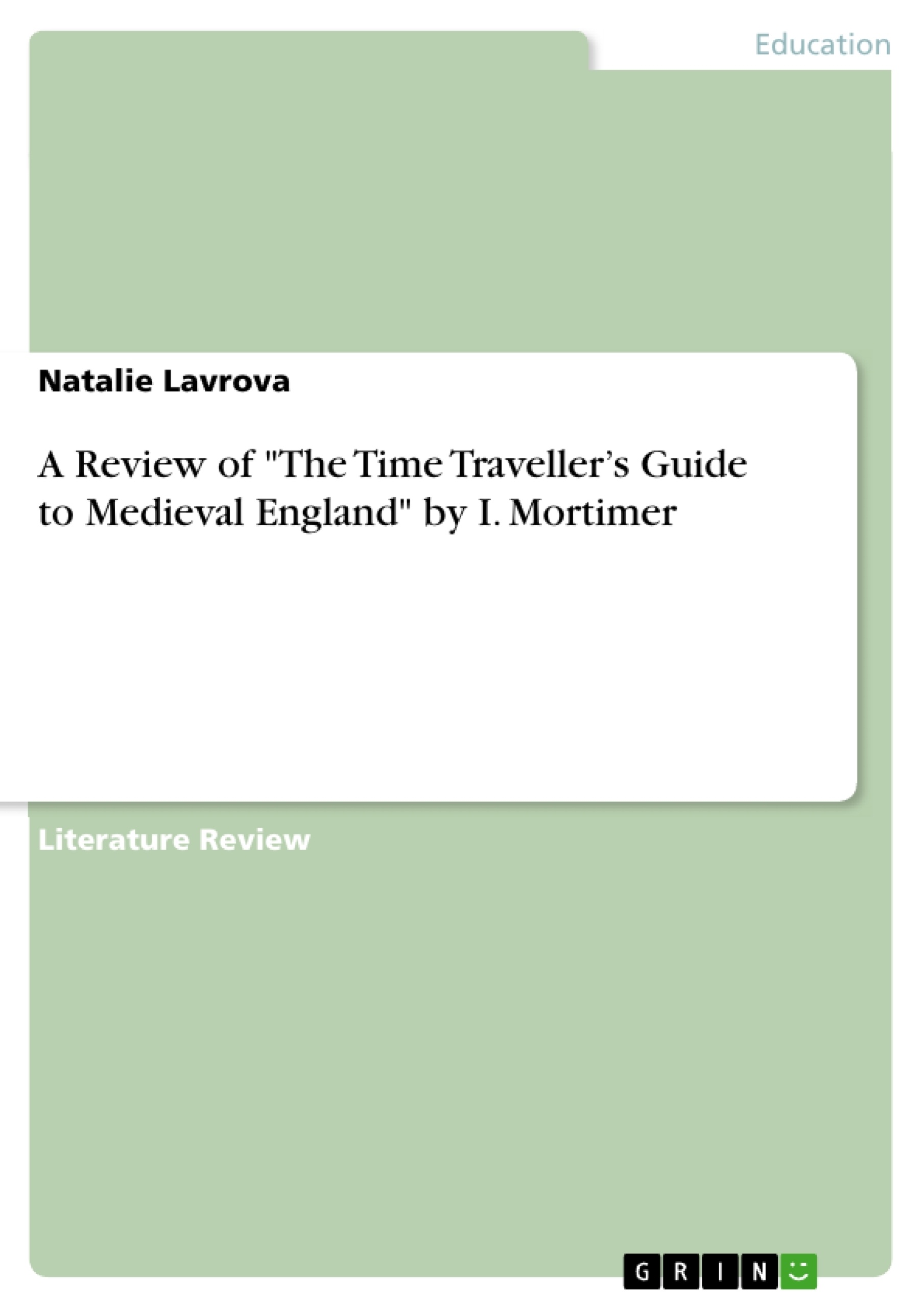“The Time Traveller’s Guide to Medieval England”, or a “Handbook for Visitors to the Fourteenth Century”, as the author chooses co call it, is a superb blend of a profound history book and an all-embracing guide to the past of England. It also reveals the writer’s smooth and easy-to-follow, easy-to-perceive literary and scientific manner of setting down every detail of medieval England. The “guide” consists of eleven sections organized, laid out, entitled and elaborated on in a traveller-friendly way.
N.A. Lavrova
A Review of “The Time Traveller’s Guide to Medieval England” by I. Mortimer
“The Time Traveller’s Guide to Medieval England”, or a “Handbook for Visitors to the Fourteenth Century”, as the author chooses co call it, is a superb blend of a profound history book and an all-embracing guide to the past of England. It also reveals the writer’s smooth and easy-to-follow, easy-to-perceive literary and scientific manner of setting down whatever he has on his mind. And on his mind he has a lot to say, much of which, however, is left outside the confines of the book. The “guide” consists of eleven sections organized, laid out, entitled and elaborated on in a traveller-friendly way, although after reading it to the very last page you, in all probability, would opt for staying where you belong – in the 21st century. At least this was my firm resolution when the sections on “Health and Hygiene” and “The Law” were left behind. Starting as a real draw and zooming in on the magnificent, awe-inspiring cathedral that dwarfs everyone and everything in sight, it proceeds to impress on you the practicalities of medieval life, the very existence of which is nothing short of a miracle, given the conditions of water conduits, the sewage, the cesspits surrounding the city and the compelling names of some streets that seem to reflect their general purpose for existence. Take, for instance, “Shitbrook”, it is not hard to guess what kind of stuff was dumped there on a daily basis and what unavoidable physical acts were performed there with the selfsame regularity. In Exeter, which is the very first city I. Mortimer sets out to describe, tubs of putrid water seem to accompany every dwelling in every street. These tubs were, more often than not, misused: meant to be reservoirs of rain water, they were also filled with the end products of the gastro-intestinal movement.
Most of the reviews and critiques of “The Time Traveller’s Guide…” are favourable, and highlight the author’s literary and scholastic merit. Here are some of them:
“After The Canterbury Tales this has to be the most entertaining book ever written about the middle ages” [ The Guardian Review Section, p. 9, Saturday 18 April, 2009 by Sue Arnold].
“What I love most about this book is the way it’s written, as if you really were travelling back in time to the medieval period, with chapter headings like What to Wear, What to Eat and Drink, and most delightfully, What to Do <…> He offers plenty of insight and advise to those wishing to experience the bucolic delights of the medieval countryside <….> Social history at its best, well-written, often amusing, and yet backed with a great deal of research. If you’re writing about the medieval period, and medieval England in particular, I highly recommend this book” [ Magical Musings, November 7th, 2009 by Michelle Diener].
“Mortimer addresses every aspect of medieval life, from the mundane to the bizarre <…> Travel guides are designed to deliver helpful information about faraway places, but this one gets to the heart of a different time zone” [ The Washington Post, Sunday, February 14, 2010 by Aaron Leitko].
Frequently asked questions
What is "A Review of 'The Time Traveller's Guide to Medieval England' by I. Mortimer" about?
This text is a review by N.A. Lavrova of Ian Mortimer's book, "The Time Traveller's Guide to Medieval England." It describes the book as a blend of a profound history book and a comprehensive guide to the past of England, highlighting Mortimer's writing style as easy-to-follow. The review also mentions the book's organization into traveller-friendly sections, while jokingly advising readers to stay in the 21st century after reading about medieval health and hygiene.
What are some positive comments about "The Time Traveller's Guide to Medieval England" that are mentioned?
The review includes several positive quotes, such as one from The Guardian Review Section calling it "the most entertaining book ever written about the middle ages" after The Canterbury Tales. Another quote, from Magical Musings, praises the writing style as if the reader were actually traveling back in time. The Washington Post notes that the book gets to the heart of a different time zone.
What are some criticisms of "The Time Traveller's Guide to Medieval England" mentioned in the review?
The review mentions a more reserved critique by Tom Holland, who points out inadequate distribution of material and undue emphasis on the negative aspects of Middle Ages Britons. Holland finds some sections fascinating but also frustrating, particularly those focusing on the physiological aspects of life in medieval England, like lavatory facilities.
What aspects of medieval England does the review highlight as being covered in "The Time Traveller's Guide to Medieval England"?
The review touches upon various aspects of medieval England as covered in the book, including magnificent cathedrals, practicalities of daily life, water conduits, sewage, cesspits, street names (like "Shitbrook"), and the overall conditions that made existence a "miracle." It also alludes to details about sheep size, the value of women, the perception of green vegetables, and sanitation practices.
- Citar trabajo
- Natalie Lavrova (Autor), 2010, A Review of "The Time Traveller’s Guide to Medieval England" by I. Mortimer, Múnich, GRIN Verlag, https://www.grin.com/document/150955



